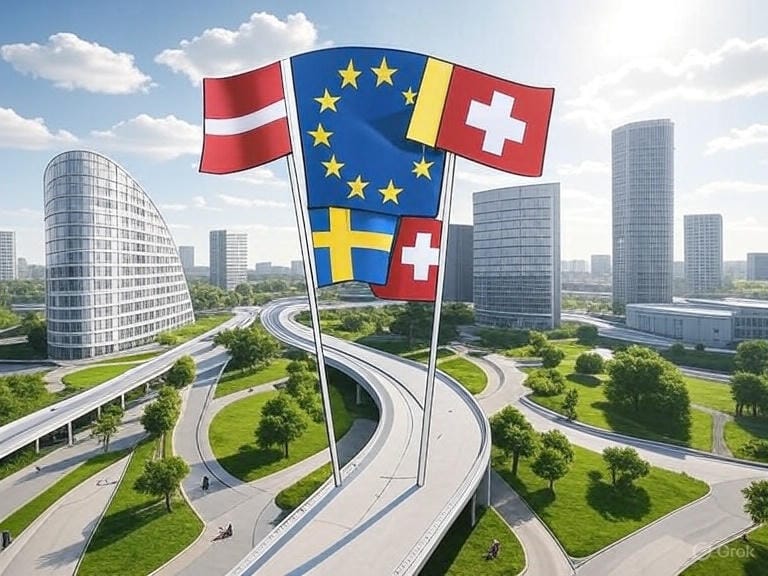Building Fortress Nations
Strong nations safeguard their future by integrating long-term planning, social unity, community strength, and proactive preparedness to thrive amidst global uncertainties.

In an era marked by geopolitical tensions, climate change, economic volatility, and technological disruptions, national resilience has become the ultimate measure of a country's strength. Resilience isn't just about bouncing back from crises—it's about anticipating them, adapting to them, and emerging stronger. Global assessments like Swiss Re's sigma Resilience Index, FM Global's Resilience Index, and U.S. News & World Report's Best Countries rankings provide valuable insights into how nations fare in this regard. These reports evaluate factors such as economic stability, disaster preparedness, social cohesion, and innovative risk management, offering a roadmap for long-term survival and prosperity.
Drawing from these analyses, this article explores the strategies employed by top-performing nations to protect themselves against uncertainties. Whether it's political divisions, environmental threats, or economic shocks, strong countries prioritize proactive measures that foster unity, build community strength, and ensure readiness. By examining what these nations do right, we can glean lessons applicable to any society aiming for enduring stability.
Understanding the Key Assessments
Swiss Re's sigma Resilience Index focuses on global insurance resilience against natural catastrophes, health risks, and economic shocks. In 2024, it reported a modest improvement in natural catastrophe resilience to 25.7%, driven by increased insurance coverage, though vast protection gaps remain, leaving three-quarters of global disaster exposure unprotected. This highlights the role of financial tools in buffering against environmental and economic uncertainties.
FM Global's 2025 Resilience Index assesses 130 countries on 18 factors, including natural hazards, cyber risks, supply chains, and economic productivity, emphasizing business environments' ability to recover from disruptions. Countries in the top 50 recover over 30% faster from property losses, underscoring the economic benefits of resilience.
U.S. News & World Report's Best Countries rankings evaluate 89 nations across categories like Quality of Life and Social Purpose, which incorporate elements of social unity, safety, and sustainability. These rankings reflect broader societal resilience, including political stability and community well-being.
Across these assessments, a pattern emerges: Nordic countries, Switzerland, and select others consistently rank high due to their holistic approaches.
| Assessment | Top Performers | Key Focus Areas |
|---|---|---|
| FM Global Resilience Index (2025) | 1. Denmark 2. Luxembourg 3. Norway 4. Switzerland 5. Singapore 6. Sweden 7. Germany 8. Finland 9. Belgium 10. Central U.S. (Zone 3) | Cyber security, climate risk management, productivity, education |
| U.S. News Quality of Life | 1. Denmark 2. Sweden 3. Switzerland 4. Norway 5. Canada 6. Finland 7. Germany 8. Australia 9. Netherlands 10. New Zealand | Economic/political stability, safety, public education/health systems |
| U.S. News Social Purpose | 1. Denmark 2. Sweden 3. Canada 4. Norway 5. New Zealand 6. Finland 7. Switzerland 8. Netherlands 9. Australia 10. Belgium | Cultural adaptability, environmental management, inclusivity |
Core Strategies of Resilient Nations
Strong nations don't leave their futures to chance. They invest in systems that promote long-term planning, social unity, community strength, and preparedness. Here's how they do it, informed by global reports like the UN's Global Assessment Report (GAR) 2025 and examples from leading countries.
1. Long-Term Planning: Investing in Sustainable Foundations
Resilient nations treat planning as a national imperative, integrating risk reduction into every aspect of governance and economy. The GAR 2025 emphasizes embedding disaster risk reduction (DRR) into national finance strategies, including analyzing funding gaps and developing comprehensive plans to protect assets. This involves resilient infrastructure investments that yield economic benefits, like debt-for-resilience swaps to free up capital for future-proofing.
Denmark, topping FM Global's index, exemplifies this through high productivity and educated workforces, supported by long-term education policies that prepare citizens for technological shifts. Switzerland, #1 in U.S. News overall, maintains economic stability via deep capital markets and insurance penetration, as noted in Swiss Re's analysis, to cushion against shocks. Singapore, ranking high in FM, advances climate risk quality through policy reforms, anticipating rising sea levels and urban heat.
These strategies ensure nations aren't reactive but proactive, democratizing risk information to make data accessible and actionable for long-term decision-making.
2. Social Unity: Fostering Inclusive Societies
Social cohesion is the glue that holds nations together during divisions. High-ranking countries build unity through equitable systems that reduce inequalities and promote trust. The GAR 2025 advocates for inclusive initiatives targeting vulnerable groups, like persons with disabilities, and using public financing to mainstream DRR across sectors.
Sweden and Norway, leaders in U.S. News Social Purpose, invest in robust welfare states that ensure family-friendly policies, political stability, and safety nets, reducing political divisions. Canada's welcoming stance on immigrants, as highlighted in its rankings, builds diverse yet unified societies, enhancing resilience to cultural or economic strains. In a global context (inspired by these benchmarks), psychological resilience is cultivated through cultural values and soft skills, fostering national solidarity.
By prioritizing equality and trust, these nations minimize internal fractures, turning potential divisions into sources of collective strength.
3. Community Strength: Empowering Local Networks
Resilience starts at the grassroots level, where communities build capacity to withstand shocks. The GAR 2025 recommends household-level actions like strengthening structures, improving drainage, and linking to early warning systems, while scaling anticipatory finance to reduce humanitarian needs. Volunteering and local groups amplify this, as seen in pandemic responses.
New Zealand, high in Social Purpose, addresses indigenous grievances through cultural pride initiatives, strengthening community bonds. Finland's vast forested landscapes foster community adaptability, with education systems emphasizing robustness from a young age. Bangladesh, though not top-ranked, offers a model for repeated flood resilience through community adaptation, inspiring global strategies.
Strong nations incentivize citizen involvement, such as through insurance tools and government programs, to create self-reliant communities.
4. Preparedness for Uncertainties: Anticipating the Unknown
In a fragmented world, preparedness means horizon-scanning and adaptive tools. Swiss Re stresses closing protection gaps via insurance growth, projecting needs for perils like convective storms. FM Global highlights cybersecurity and supply chain fortification, with top countries like Luxembourg and Germany excelling in these.
The GAR 2025 calls for innovating risk transfer (e.g., sustainable insurance) and investing in foresight capacity to handle volatile risks. Denmark's robust cybersecurity reflects this, while Australia's proposed "just-in-case" strategy shifts from efficiency to redundancy in supply chains. Australia and the Netherlands manage water-related risks through advanced planning, adapting to environmental uncertainties.
By conducting regular risk assessments and building buffers, these nations turn uncertainties into manageable challenges.
Lessons for the World
The world's strongest nations teach us that resilience is a deliberate choice, woven into the fabric of society through planning, unity, community empowerment, and foresight. As global risks intensify—from climate events to cyber threats—emulating these strategies can help any country thrive. Start with accessible risk data, invest in people, and build inclusive systems. In the end, resilience isn't just about survival; it's about creating a legacy of strength for generations to come.





